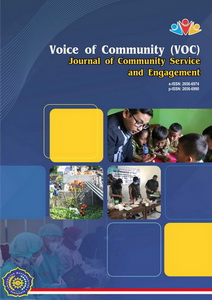ASQ: SE-3 Application as an Innovation in Helping Stimulate Children’s Growth and Development for Paediatric Physiotherapy Teaching Materials
DOI:
https://doi.org/10.23917/voc.v5i1.10087Keywords:
ASQ:SE-3, Child development screening, Technology Development, Pediatric, PhysiotherapyAbstract
Background: Mobile applications are now a solution to the challenges of monitoring children's growth and development, helping in understanding the emotional and behavioural aspects of children. However, a mobile application-based questionnaire management system for physiotherapy is still not available, therefore, the development of the "ASQ: SE-3" application is needed. This application is expected to help physiotherapy students screen children's growth and development and identify problems early. Methodology: The community service carried out by the service team was carried out through several stages, namely the observation stage, to the evaluation stage using the function test technique with an assessment in descriptive form. This technique is carried out to determine whether there is a difference between the product and its function so that an evaluation can be made. The population of this community service is physiotherapy students of Universitas Muhammadiyah Surakarta. Results: In the evaluation results provided by the student service team revealed that the ASQ: SE-3 Application is good enough, maybe a little more promoted so that the tool can be known by many people and is useful in addition to physiotherapy teaching materials. Conclusion: The ASQ:SE-3 application proved to be useful as a tool to monitor children's growth and development as an innovative physiotherapy teaching material. However, challenges faced in its use include the possibility of technical errors and limited features that need to be improved to make it easier to use.
Downloads
References
Chandran, V., Balakrishnan, A., Rashid, M., Kulyadi, G. P., Khan, S., Devi, E., Nair, S., & Thunga, G. (2022). Mobile applications in medical education: A systematic review and meta-analysis. PLoS ONE, 17. https://doi.org/10.1371/journal.pone.0265927
Lufthansa, L., Saputro, Y. D., Rohmah, L. N., Yusuf, H., & Artanty, A. (2022). Analisis Kebutuhan Pengembangan Bahan Ajar Elektronik Mata Kuliah Penjas Adaptif Di Ikip Budi Utomo. Journal of Sport Science and Fitness, 8(1), 23–32. https://doi.org/10.15294/jssf.v8i1.58141
Muh David Balya Al. (2023). Kemajuan Teknologi Dan Pola Hidup Manusia Dalam Perspektif Sosial Budaya. TUTURAN: Jurnal Ilmu Komunikasi, Sosial Dan Humaniora, 1(3), 26–53. https://doi.org/10.47861/tuturan.v1i3.272
Nurul, H. (2024). Early Childhood Social And Emotional Development In Islamic Education. Edukasi Islami: Jurnal Pendidikan Islam, 13(01), 109–118. https://doi.org/10.30868/ei.v13i01.6196
Putri, D. D., Andini, S., Ingtyas, F., & Sabrina, E. (2024). Meta-Analysis the Impact of Technological Advancements on Social Interaction in the Digital Era. Journal Corner of Education, Linguistics, and Literature. https://doi.org/10.54012/jcell.v4i001.359
Uce, L. (2017). The Golden Age : Masa Efektif Merancang Kualitas Anak. Bunayya : Jurnal Pendidikan Anak, 1, 77. https://doi.org/10.22373/bunayya.v1i2.1322
Downloads
Submitted
Accepted
Published
How to Cite
Issue
Section
License
Copyright (c) 2025 Adnan Faris Naufal, Aldila Lutfi Asmarasikha, Anida Fitri Azkia

This work is licensed under a Creative Commons Attribution 4.0 International License.








